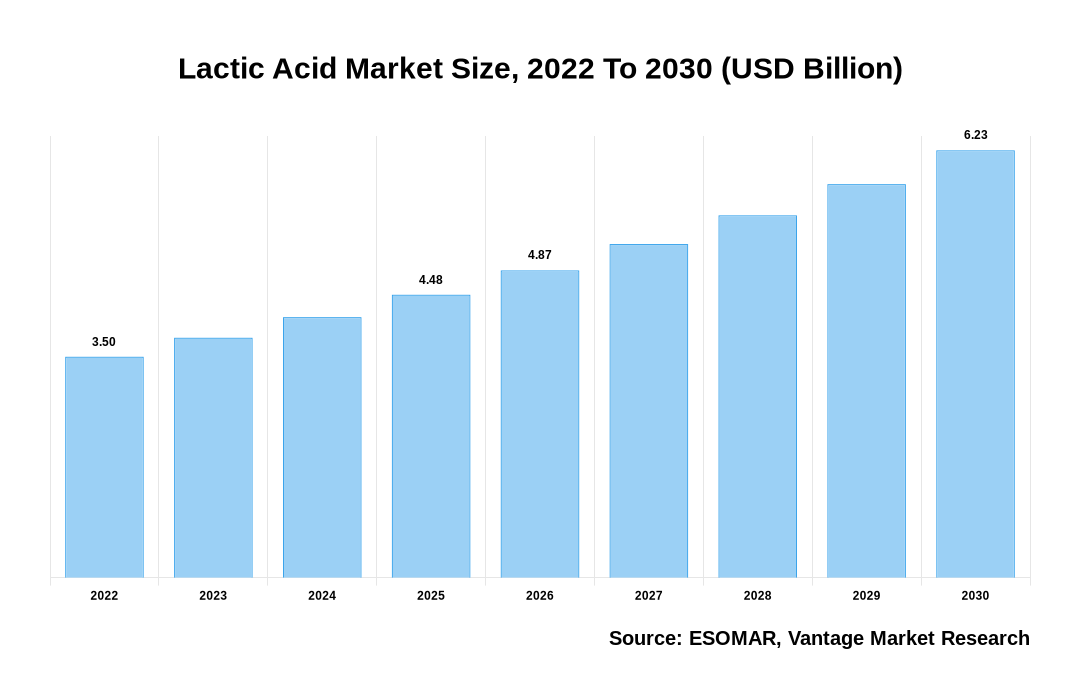Global Lactic Acid Market
As stated in our extensive report; the Global Lactic Acid Market accounted for USD 3.5 Billion in the year 2022 and is projected to reach a value of USD 6.23 Billion by 2030 at a CAGR (Compound Annual Growth Rate) of 8.6% between 2023 and 2030.
The global Lactic Acid market is expected to grow significantly in the coming years due to various factors. One of the major drivers is the increasing demand for biodegradable plastics. Lactic Acid is used as a raw material to produce polyLactic Acid (PLA), a biodegradable plastic. The growing concerns regarding environmental pollution and the adverse impact of conventional plastics on the environment have led to adoption of biodegradable plastics, driving the demand for Lactic Acid. Another key market driver is the growing demand for personal care products, especially in emerging economies. Lactic Acid is used to manufacture a range of unique care products, including creams, lotions, and hair care products. The increasing disposable income of consumers in emerging economies drives demand for personal care products, boosting the demand for Lactic Acid.
Click To Get a Free Sample On the Research Study

The pharmaceutical industry is another important factor driving the market growth. Lactic Acid is used as an excipient in manufacturing various pharmaceutical products, including tablets, injectables, and oral suspensions. The increasing demand for pharmaceutical products, particularly in emerging economies, drives the need for Lactic Acid. The food and beverage industry is also a significant driver of the market. Lactic Acid is used as a food additive, preservative, and flavoring agent in various food products, including dairy products, meat, and baked goods. The increasing demand for processed and packaged food products globally, particularly in developing economies, is driving demand for Lactic Acid. Thus, the growing demand for biodegradable plastics, personal care products, pharmaceuticals, and processed and packaged food products drives the need for Lactic Acid globally.
These are the primary factors that must be considered to propel the growth of the global Lactic Acid market. However, the development of alternative feedstocks such as lignocellulosic biomass and waste materials can provide a solution to this problem. Additionally, increasing demand for bioplastics and biodegradable materials can create new opportunities for the market.
Key factors influencing Lactic Acid Market Growth
The growth of the global Lactic Acid market can be attributable to the following
- As consumers become more environmentally conscious, there is a growing demand for sustainable and eco-friendly products. Lactic Acid is a natural and biodegradable acid that can replace harsh chemicals in various applications, such as food and personal care products, creating a significant opportunity for market growth.
- Lactic Acid is a key ingredient in many personal care and cosmetic products due to its exfoliating and brightening properties. With the growing focus on personal hygiene and appearance, the cosmetic industry is expected to drive the market’s growth.
- The demand for bioplastics is increasing globally due to growing environmental concerns regarding traditional plastic’s non-biodegradable nature. Lactic Acid is used in the production of poly Lactic Acid (PLA), a biodegradable plastic that is expected to drive market growth.
- Lactic Acid is used as a natural preservative in food products such as dairy, meat, and bakery products, where it acts as an antimicrobial agent. The rising demand for natural food preservatives is expected to boost market growth.
- Lactic Acid is used as a feed additive in animal feed to promote gut health and improve digestion. With the increasing demand for quality meat and animal products, the animal feed industry is expected to drive market growth.
- The rapid industrialization in emerging economies is expected to boost market growth as Lactic Acid is used in several industrial applications, including biodegradable plastics, textiles, and pharmaceuticals.
- Several governments worldwide are implementing policies and initiatives promoting sustainable development, leading to an increase in demand for eco-friendly and biodegradable products. This trend is expected to boost the Lactic Acid market growth.
- Lactic Acid and its derivatives are increasingly used in various health-related applications due to their antibacterial and anti-inflammatory properties. The growing awareness of these health benefits is expected to lead to increased demand and market growth.
North America Region to Lead the Market
North America Lactic Acid market is getting more significant with maximum market share during the forecast period. The growing population in countries like China, India, and Indonesia is contributing to the increase in demand for Lactic Acid in food, beverage, and other end-use industries. Moreover, the region is witnessing a rise in per capita income, increasing the consumption of processed foods and personal care products, thus boosting the market growth of Lactic Acid. The presence of significant manufacturers and suppliers of Lactic Acid in the North America region has also contributed to the market growth. Manufacturers in the region are investing heavily in R&D to introduce innovative products and increase their production capacities to meet the growing demand. Furthermore, favorable government policies and initiatives promoting the use of bio-based products are creating lucrative opportunities for market players in the region.
Conclusion
Increasing environmental regulations and initiatives by governments across the globe to promote the use of bio-based products, are positively influencing the overall Lactic Acid market.
Some of the key players in the Global Lactic Acid Market include- Futerro Group (Belgium), BASF SE (Germany), Galactic (Belgium), Henan Jindan Lactic Acid Technology Co. Ltd. (China), Musashino Chemical Co. Ltd. (China), Corbion (Netherlands), Thyssenkrupp AG (Germany) and others.
![[Market Research Reports] – Research Google News Blog | VMR.Biz](https://www.vmr.biz/wp-content/uploads/2022/12/logo-removebg-preview.png)











